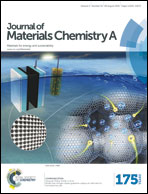FeOx@carbon yolk/shell nanowires with tailored void spaces as stable and high-capacity anodes for lithium ion batteries†
Abstract
Transition metal oxides as anodes of lithium ion batteries (LIBs) promise high theoretical capacities. However, the significant volume change upon lithium insertion/extraction cycles causes pulverization of the materials, leading to a quick loss of electrical conductivity and a rapid decrease in capacity. The present work provides a possible solution to this problem by using a yolk/shell nanostructure featuring porous FeOx nanowires encapsulated with carbon shells as anodes. It was found that the FeOx@carbon yolk–shell nanowires with a volumetric ratio (void/FeOx) of ∼1.04 present high gravimetric and volumetric capacities of 1045.4 mA h g−1 and 380.5 mA h cm−3 at 0.2 A g−1, respectively, a good rate capability at various current densities and a robust cycling stability. The appropriate void space plays a critical role in accommodating volume swing, preserving the structural integrity of porous FeOx nanowires, confining electroactive materials inside of carbon shells and maintaining good electrical contact between FeOx and carbon shells during the lithiation and delithiation cycling. However, if the void space is too small or too large, the structural damage of FeOx@C yolk/shell nanowires would occur attributed to a large volume expansion (∼90%) during lithiation/delithiation processes or the divulgation of the pulverized FeOx from carbon shells, respectively, leading to their poor performance as anodes of LIBs.


 Please wait while we load your content...
Please wait while we load your content...